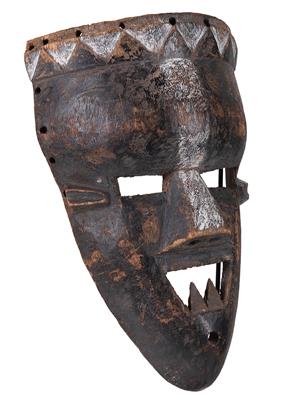Salampasu (or Basalampasu), Democratic Republic of Congo: a mask of the ‘Kasangu’ type, that could only be worn by successful warriors.
Salampasu (or Basalampasu), Democratic Republic of Congo: a mask of the ‘Kasangu’ type, that could only be worn by successful warriors.

Amongst the Salampasu in southern Congo, such ‘Kasangu’ masks could once only be worn by warriors who had already killed an enemy. They appeared at initiations and gatherings of the warrior societies. There are two very similar types of these Salampasu masks: ‘Kasangu’ is made of carved wood, and dyed black and white. The second type is called ‘Mukinka’ and always displays a detailed coating of copper sheeting. This ‘Mukinka’ type was reserved only for high-ranking members of the warrior secret society.
The present ‘Kasangu’ mask is carved from very hard wood, and was originally coloured black and white on the front side. It displays the typical features of such Salampasu masks: the bulging forehead, angular eyes, small ears, a short, wide nose and a trapezoidal, open mouth with jagged teeth. A ‘beard’ made from a string of plaited plant fibres was attached through the hole in the relatively pointed chin. On this string hung a small sphere made of braided rattan strips. More of these rattan spheres were tied into the holes at the upper rim of the mask, as a ‘hairstyle’, above the black and white relief band resembling a crown. In the holes at the edge of the forehead a net was tied, which was pulled over the head of the mask dancer thereby fixing the mask in front of his face. A well-preserved piece with two minor breaks, at the left eye and at the upper edge, as well as with some colour scuffing due to age on the front. On the back the ‘Kasungu mask’ displays a perfect usage patina at the correct places (forehead, nose and cheeks).
Height: 27 cm; width: c. 17 cm.
First half of the 20th century. (ME)
Provenance:
Austrian collection.
Lit.:
‘Het Gelaat van de Geesten. Maskers uit het Zairebekken’ by Frank Herreman & Constantijn Petridis, ill. 51; ‘Encyclopedia of African Art and Culture’ by K.-F. Schädler, ill. p. 527; ‘Utotombo. Afrikanische Kunst in belgischem Privatbesitz’, ill. 200.
Esperto: Prof. Erwin Melchardt
 Prof. Erwin Melchardt
Prof. Erwin Melchardt
+43-1-515 60-465
erwin.melchardt@dorotheum.at
20.02.2017 - 14:00
- Prezzo di partenza:
-
EUR 900,-
Salampasu (or Basalampasu), Democratic Republic of Congo: a mask of the ‘Kasangu’ type, that could only be worn by successful warriors.
Amongst the Salampasu in southern Congo, such ‘Kasangu’ masks could once only be worn by warriors who had already killed an enemy. They appeared at initiations and gatherings of the warrior societies. There are two very similar types of these Salampasu masks: ‘Kasangu’ is made of carved wood, and dyed black and white. The second type is called ‘Mukinka’ and always displays a detailed coating of copper sheeting. This ‘Mukinka’ type was reserved only for high-ranking members of the warrior secret society.
The present ‘Kasangu’ mask is carved from very hard wood, and was originally coloured black and white on the front side. It displays the typical features of such Salampasu masks: the bulging forehead, angular eyes, small ears, a short, wide nose and a trapezoidal, open mouth with jagged teeth. A ‘beard’ made from a string of plaited plant fibres was attached through the hole in the relatively pointed chin. On this string hung a small sphere made of braided rattan strips. More of these rattan spheres were tied into the holes at the upper rim of the mask, as a ‘hairstyle’, above the black and white relief band resembling a crown. In the holes at the edge of the forehead a net was tied, which was pulled over the head of the mask dancer thereby fixing the mask in front of his face. A well-preserved piece with two minor breaks, at the left eye and at the upper edge, as well as with some colour scuffing due to age on the front. On the back the ‘Kasungu mask’ displays a perfect usage patina at the correct places (forehead, nose and cheeks).
Height: 27 cm; width: c. 17 cm.
First half of the 20th century. (ME)
Provenance:
Austrian collection.
Lit.:
‘Het Gelaat van de Geesten. Maskers uit het Zairebekken’ by Frank Herreman & Constantijn Petridis, ill. 51; ‘Encyclopedia of African Art and Culture’ by K.-F. Schädler, ill. p. 527; ‘Utotombo. Afrikanische Kunst in belgischem Privatbesitz’, ill. 200.
Esperto: Prof. Erwin Melchardt
 Prof. Erwin Melchardt
Prof. Erwin Melchardt
+43-1-515 60-465
erwin.melchardt@dorotheum.at
|
Hotline dell'acquirente
lun-ven: 10.00 - 17.00
kundendienst@dorotheum.at +43 1 515 60 200 |
| Asta: | Tribal Art |
| Tipo d'asta: | Asta in sala |
| Data: | 20.02.2017 - 14:00 |
| Luogo dell'asta: | Wien | Palais Dorotheum |
| Esposizione: | 11.02. - 20.02.2017 |
